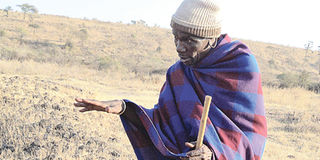Another footprint of early man found in Ngorongoro

A curator of Laetoli archeological site in Ngorongoro Conservation Area (NCA) where archeologists traced footprints of early man, speaks to journalists who toured the area in the recent past. PHOTO | FILBERT RWEYEMAMU
What you need to know:
A team of researchers led by Prof Fidelis Masao of the University of Dar es Salaam recently stumbled upon a new set of footprints on a four-million-year-old ash bed close to the remote area where the previous ones were discovered nearly 40 years ago by Dr Mary Leakey.
Arusha. More evidence suggesting that Tanzania is the cradle of mankind are emerging. This time, archaeologists have reported another set of hominid footprints at the famous Laetoli site within the Ngorongoro Conservation Area in Arusha region.
A team of researchers led by Prof Fidelis Masao of the University of Dar es Salaam recently stumbled upon a new set of footprints on a four-million-year-old ash bed close to the remote area where the previous ones were discovered nearly 40 years ago by Dr Mary Leakey.
“This is yet another proof that Tanzania remains the cradle of mankind,” he told reporters, adding that different sets of footprints found there indicated that early man on earth walked or inhabited the Laetoli and Ngorongoro areas millions of years ago.
He told reporters here at the weekend that while the footprints discovered by Dr Leakey covered a stretch of 60 metres of two predecessors of the modern man, the recent discovery indicated three walking trackways indicating with three people walked on the site.
Prof Masao said there were indications that the Laetoli area, south-west of the Ngorogoro crater, was laden with footprints of the pre-historic man who roamed that part of the ancient world millions of years ago.
The don said archaeological researchers are still waiting to see implementation of a pledge made by the government some years ago to construct a museum at Laetoli which has been made famous the world over because of the hominid footprints.
“This is an important site not only for Tanzania but to the entire world and should be preserved for the present and future generations,” he stressed, adding that these can also add value to Tanzania’s tourism sector.
Prof Masao, an old hand in archaeological research within the East African region, also emphasised the need to preserve the ash beds on which the footprints were found, for he fears they could be eroded.
Four years ago, experts dug up the ash bed with the 3.6 million year old hominid footprints with little likelihood of putting them in a museum for display as President Jakaya Kikwete visited the area.
Mr Donatus Kamamba, the director of Antiquities in the ministry of Natural Resources and Tourism confirmed yesterday after trackway had been observed, it will be reburied in the same site.
“The proposal by the President to preserve the footprints in a museum will not be implemented now”, he said on phone from Laetoli yesterday.
He said Mr Kikwete would be at the remote site in Ngorongoro Crater tomorrow at the climax of the excavation exercise involving archaeological experts from within and outside the country.
Some years ago, during his visit to the area, President Kikwete criticised decision by American experts to bury the famous footprints said to be the oldest in the world. In a move that was supported by other archaeologists and stakeholders in tourism, the President directed that they be exhumed and displayed for the public.
The President did not like the way the unique archaeological relics were preserved underground instead of in a museum to attract more tourists.




